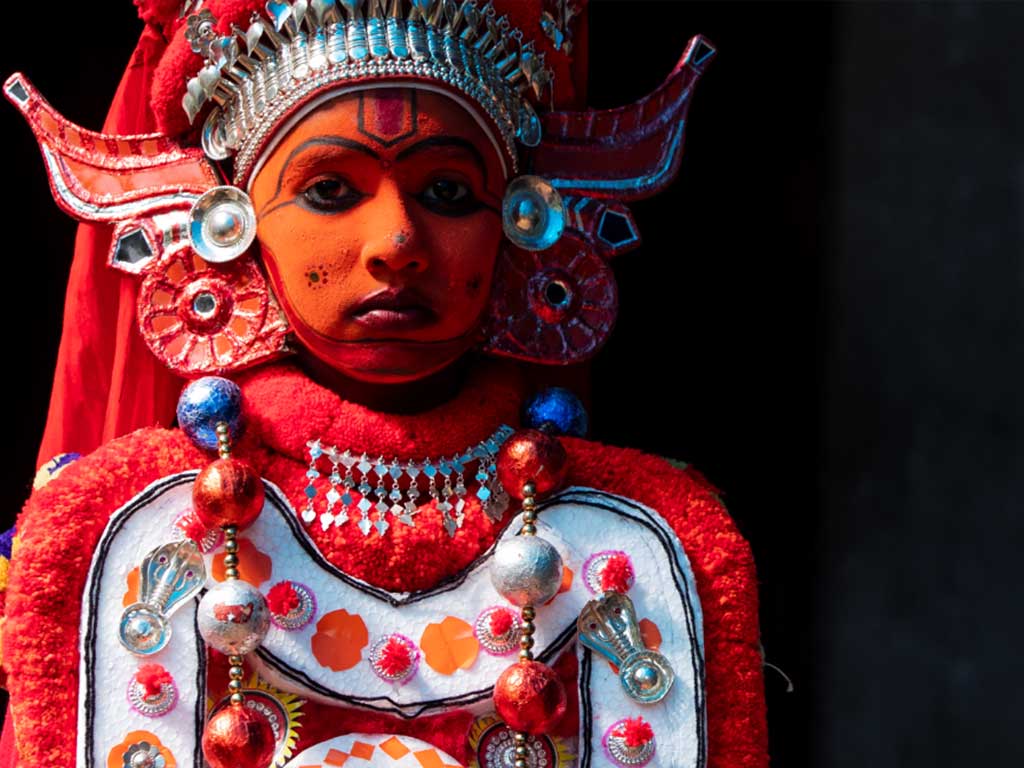Yakshaganam
One of the most important folk theatres of Karnataka and Kasaragod yakhaganam has carved a unique niche for these two places in the cultural map of India. No wonder why the villages are replete with eminent yakshagana artistes for it is the most cherished cultural possession of these people. To the villagers this art form is as close to them as their mother tongue. Most of the stories in yakshagana are drawn from the epics like Ramayana, Mahabharata, Bhagavatha and other mythological episodes. Though it is generally described as folk art it has strong classical connections.
The name yakshagana suggests the music of celestial beings. Originally yakshagana was known by different names to different people. For instance Bayatala is a name for yakshagana familiar to some people in Karnataka. In kannada bayatala denotes an art form presented in the open air. The Terukkuthu of Tamilnadu, Kootiyatam and Chakyarkuttu of Kerala, Veedhinataka of Andhra Pradesh can be considered as sister art forms.
Yakshagana is a musical dance drama. Singing and drumming merge with dancing, and words with gestural interpretation, and players clad in costumes of striking colour and contours are parts of the dance form. In Yakshagana music and speech go hand in hand and both could reach a good distance without our modern sound system. It is believed that the art form of yakshagana was originated in South Canara District of Karnataka and Kasaragod District of Kerala. Parthisubha one of the pioneers of yakshagana hails from kasaragod district. In India almost all the art forms, in one way or the other, are related to the worship of god. These art forms help to inculcate the religious, cultural and ethical values in the minds of the people. Yakshagana is believed to have evolved from the ancient Bhutha-worship prevalent in South Canara and Kasaragod. Theyyam is also a manifestation of this Bhutha worship. But it is evident from the performance that Yakshagana is also influenced by the folk dance and Sanskrit drama. Bharatha’s Natyashasthra also has had its influence on this art form.
The dance drama Yakshagana is broadly divided into two1. MoodalapayaThe Moodalapaya is divided into Doddata and Sannata which are crude forms of Yakshagana i.e., purely folkform
2. Paduvalapaya The Paduvalapaya is again divided into Thenkuthittu and Badaguthittu. The Badaguthittu is very popular in North Canara Dist. of Karnataka and Thenkuthittu is in the erstwhile South Canara Dist. (including Kasargod Dist). These two groups are distinguished by their costumes used by the troupes and the dance style (Angika). Thenkuthittu costumes resemble that of the Kathakali to a certain extent.
Stage craft The stage craft is the most alluring element of yakshagana. The craft renders the stage a supernatural ambience and the characters (gods, demons and saints) are presented in this uncanny world that will take the audience into a different world. The performances are usually carried out at night lasting from 9.00PM to 6.00AM in the open-air. The stage of Yakshagana is rectangular in shape measuring about15’x 30' prescribing the rule in the given Sanskrit sloka. The narrator who is known by the name Bhagavatar sits with his accompaniment on one side of the floor. He is also the director (suthradhara) of this dance drama. The Bhagavatha sings with the accompaniment of Tala(Jagate) Mridanga(Maddale), Harmonium(Shruthi) and Chakrathala. The high pitched Chenda is also used in some rare occasions. In the past oil lamps were the only source of light that illuminated the stage for the audience.
The yakshagana performances start and end with the prayer to Lord Ganesha. Yakshagana Prasanga or the text of the yakshagana is narrated in sets of songs. These songs are set of different Ragas and Talas presented according to the "Kalas" (Periods of night). There are about 100 ragas in yakshagana Some of the Ragas of yakshagana are not heard of in Karnataka Music viz., Panchagandhi, Gopanitem Kore,Koravy etc, The characters will dance to the tune of the songs followed by the dialogue in Kannada. The dialogue is presented extempore within the framework of the text of songs.
The only other art form to which the yakshagana can be compared is Kathakali. But unlike Kathakali Yakshagana is a true people’s art and it has everything of a performing art that would force one to call it a total theatre. It entertains and enlightens both the learned and the illiterate. This extraordinary art necessitates systematic training in dance, music, dialogue and makeup. An artist should take great effort to master the dialogue and makeup. All forms of Abhinaya viz., Angika, Vachika, Aaharya and Bhava follow a fixed development over the centuries. The Characters of this art can be distinguished as Romantic and Demonical. The roles of Karna, Arjuna etc., are treated as romantic roles, using colourful and pleasing costumes whereas Ravana, Mahishasura, Duryodhana etc., are treated as demonical role and their facial makeup is very intricate resembling Kathakali techniques painted by the artists himself.
The costume used by the characters reflects his habit and behavior. The artists playing Satvika and Sringara roles use green shirts named Dagale. Rajasa use Red shirt and Tamasa black shirt. The main alankara of the head is called Kedge-Mundale, Mundas(Pagadi)Kirita Kesarithattu and Mudi. The main colour for the face decoration is called Aradala (Chayam), Ingalika (red), Green, Kadige, Calcium (SUNNA), rice powder and Kumkuma. Even the clour of the face changes according to the character.
Yet another variety of yakshagana is the "Yakshagana Koota" or "Talamaddale" It is performed by the artists without makeup and costumes. Though the musical accompaniments are the same as in Yakshagana, no elaborate costumes or make up are used by the artists.


 Theyyam
Theyyam